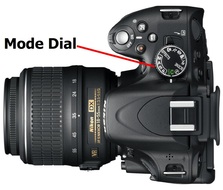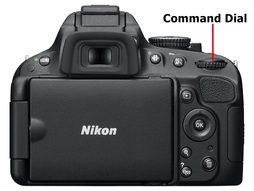Using Your Camera's Program "P" Mode

Using your camera's program mode is similar to using the automatic mode, but it is also very different. It is similar because the lens aperture opening and shutter speed are chosen by the camera to produce a "Correct" or standard exposure in both modes. When the program mode is used, your camera can be used as a "point and shoot" camera as far as exposure settings go.
However, if desired, the lens aperture and shutter speed can still be controlled to a certain extent when you are using the program mode. That will be discussed a bit more later in this tutorial.
Additionally, what makes using the program mode different from using the automatic mode is that the user is able to manually control certain functions that can't be changed in the automatic mode. Those settings may include the ISO, flash, white balance and focusing functions among others.
Basic compact cameras will not have a "P" or Program mode: That is because they are designed so that just about every camera function is set automatically. However, Advanced, Bridge Type compact cameras like the Canon Powershot SX620 HS will have a program mode function. All Digital SLR cameras, and Mirrorless Compact System cameras have the Program Mode function.
Why is the Program Mode Useful? The Program mode gives the photographer the option of shooting freely without having to worry about what are the best exposure settings to use. (since it can function the same as an automatic mode) Yet, the photographer can learn and get used to using the other functions of the camera as needed.
How does the Program Mode work? First, set your camera mode dial to the "P" or Program mode. Cameras may differ as to how you change your camera to the program mode so check your camera's instruction manual for details.
The picture to the right being used as an example is a Nikon Digital SLR camera. Once you are in the P mode, point your camera at the subject and press the shutter half way down. You will see the shutter speed and lens aperture setting the camera has chosen for a good exposure in the viewfinder.
If all looks well, just fire away. On the other hand, If you decide that a certain camera setting like the light metering mode or white balance needs to be adjusted, it is not a problem when using the Program Mode. Just change the setting and the camera will still set the lens aperture opening and shutter speed to produce a standard exposure.
However, if desired, the lens aperture and shutter speed can still be controlled to a certain extent when you are using the program mode. That will be discussed a bit more later in this tutorial.
Additionally, what makes using the program mode different from using the automatic mode is that the user is able to manually control certain functions that can't be changed in the automatic mode. Those settings may include the ISO, flash, white balance and focusing functions among others.
Basic compact cameras will not have a "P" or Program mode: That is because they are designed so that just about every camera function is set automatically. However, Advanced, Bridge Type compact cameras like the Canon Powershot SX620 HS will have a program mode function. All Digital SLR cameras, and Mirrorless Compact System cameras have the Program Mode function.
Why is the Program Mode Useful? The Program mode gives the photographer the option of shooting freely without having to worry about what are the best exposure settings to use. (since it can function the same as an automatic mode) Yet, the photographer can learn and get used to using the other functions of the camera as needed.
How does the Program Mode work? First, set your camera mode dial to the "P" or Program mode. Cameras may differ as to how you change your camera to the program mode so check your camera's instruction manual for details.
The picture to the right being used as an example is a Nikon Digital SLR camera. Once you are in the P mode, point your camera at the subject and press the shutter half way down. You will see the shutter speed and lens aperture setting the camera has chosen for a good exposure in the viewfinder.
If all looks well, just fire away. On the other hand, If you decide that a certain camera setting like the light metering mode or white balance needs to be adjusted, it is not a problem when using the Program Mode. Just change the setting and the camera will still set the lens aperture opening and shutter speed to produce a standard exposure.

Changing Shutter Speed and Lens Aperture while in the Program Mode: Not having to set the shutter speed or lens aperture opening when using the program mode is a great feature. However, there may be times when adjusting those settings might produce a better image.
For instance, lets say you are taking pictures of a sporting event with lots of fast movement. There might be blurring in your pictures because the shutter speed chosen by the camera is too slow to freeze the movement. No problem. If you are using a camera like the Nikon D3500, just rotate the Command dial until you reach the desired faster shutter speed. The camera will automatically adjust the lens aperture opening by the same amount of stops to maintain the "correct" exposure.
If it is the lens aperture opening that you want to change, rotate the Command dial until you reach the aperture setting you want and the camera will automatically adjust the shutter speed to maintain a good exposure.
Changing those setting while in the Program mode is referred to as using the Program Shift feature in many cameras. In the case of some Nikon cameras it is called the Flexible mode.
The same results can be obtained by using either the Aperture Priority or Shutter Priority modes. However, for some users it might be easier to just leave the camera in the Program mode. (for ordinary picture taking situations) So if an adjustment of shutter speed or lens aperture opening is needed, that change can be quickly made without leaving the program mode.
In closing, using the Program Mode is an easy way to take pictures without being concerned about setting exposure values. Yet you will still have control over all other camera functions. Lastly, if you choose to do so, you can still manually change the lens aperture or shutter speed to a certain extent while using the program mode.
For instance, lets say you are taking pictures of a sporting event with lots of fast movement. There might be blurring in your pictures because the shutter speed chosen by the camera is too slow to freeze the movement. No problem. If you are using a camera like the Nikon D3500, just rotate the Command dial until you reach the desired faster shutter speed. The camera will automatically adjust the lens aperture opening by the same amount of stops to maintain the "correct" exposure.
If it is the lens aperture opening that you want to change, rotate the Command dial until you reach the aperture setting you want and the camera will automatically adjust the shutter speed to maintain a good exposure.
Changing those setting while in the Program mode is referred to as using the Program Shift feature in many cameras. In the case of some Nikon cameras it is called the Flexible mode.
The same results can be obtained by using either the Aperture Priority or Shutter Priority modes. However, for some users it might be easier to just leave the camera in the Program mode. (for ordinary picture taking situations) So if an adjustment of shutter speed or lens aperture opening is needed, that change can be quickly made without leaving the program mode.
In closing, using the Program Mode is an easy way to take pictures without being concerned about setting exposure values. Yet you will still have control over all other camera functions. Lastly, if you choose to do so, you can still manually change the lens aperture or shutter speed to a certain extent while using the program mode.